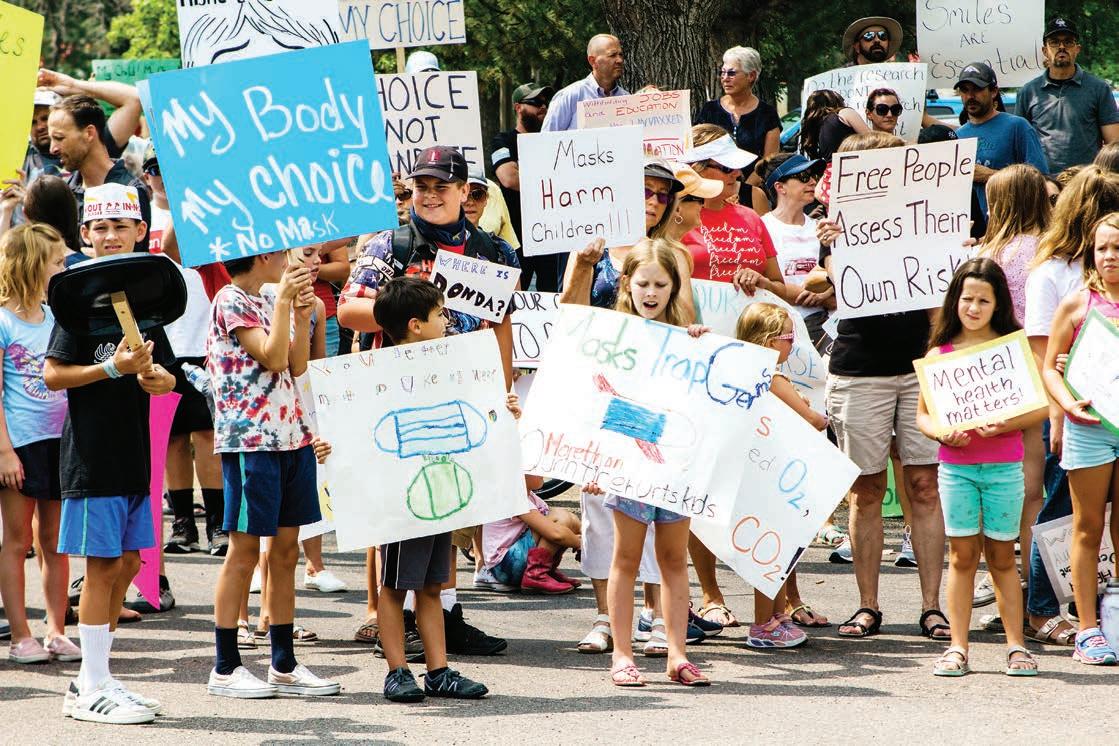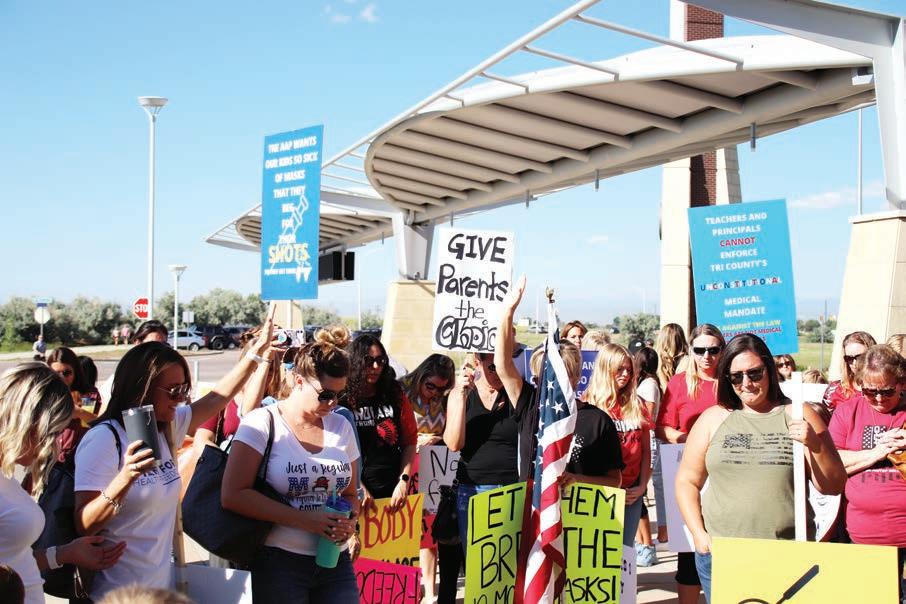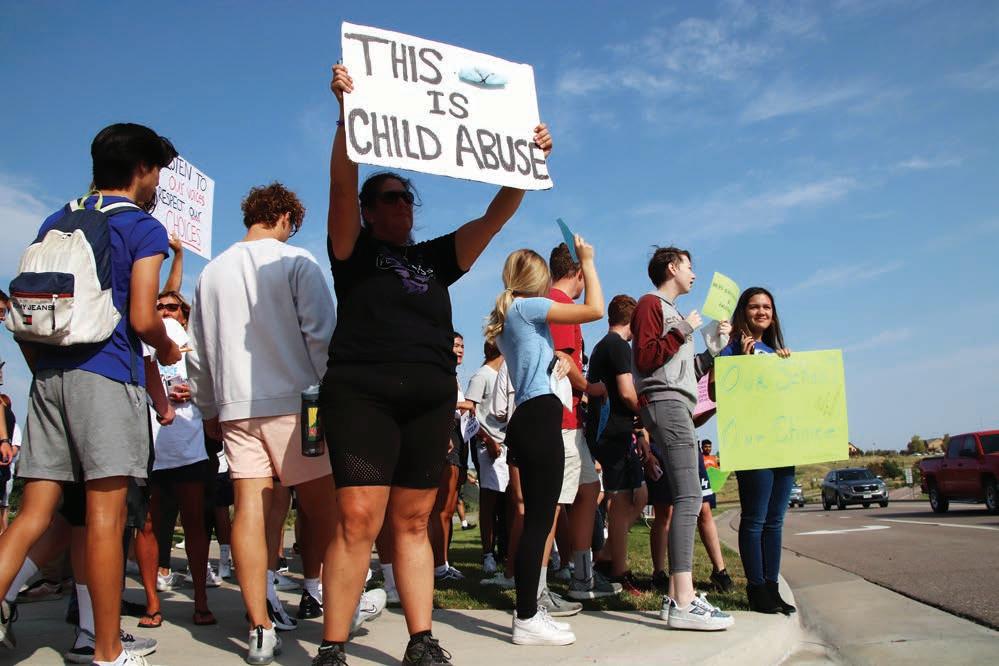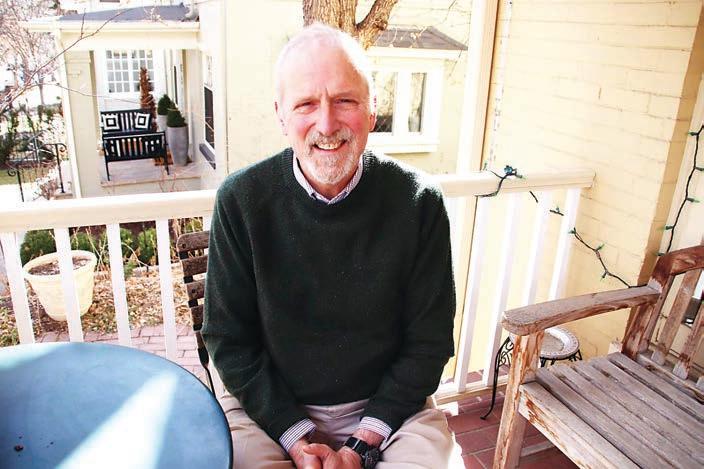
19 minute read
SEE MASKS
may fi nally be coming back down, Colorado’s number of COVID-19 patients still sits high above what it was during most other parts of the pandemic.
Colorado had 1,368 people hospitalized with confi rmed COVID-19 as of Dec. 3 this year, according to state data. Colorado had the 10thhighest COVID-19 hospital demand in the United States as of early November, according to a Nov. 3 report by the Colorado School of Public Health.
But with the public hearing so many concerns about masks and mask effectiveness — and about vaccines — why wear a mask? Why get vaccinated when so many people already have been?
Colorado Community Media spoke to Douglas and reviewed other sources of information below to address those questions.

Like ‘sand through a chain-link fence’
At a contentious public comment session in front of Arapahoe County’s elected leaders after Tri-County Health issued its school mask order in August, a man offered an evocative picture of how he thought masks interact with the coronavirus.
“If you took a fi st of sand and threw it through a chain-link fence, imagine how much of it would go through,” the man said during the meeting, noting how small the virus is.
A post on a popular social media page last year, focusing specifi cally on N95 masks, said: “COVID 19 virus particle size is 125 nanometers (0.125 microns); the range is 0.06 microns to .14 microns,” the post said, according to a USA Today factcheck report. “The N95 mask fi lters down to 0.3 microns. So, N95 masks block few, if any, virions (virus particles).”
A micron is one one-thousandth of a millimeter — it’s also referred to as a micrometer.
But there’s more to it than that. A COVID-19 virus particle exists on a tiny scale — around 0.1 microns in size — but it is always bonded to something larger, an expert told USA Today for the report. In other words, masks don’t have to stop bare virus particles alone.
“There is never a naked virus fl oating in the air or released by people,” Linsey Marr, a professor of civil and environmental engineering at Virginia Tech who specializes in airborne transmission of viruses, told USA Today.
The virus attaches to water droplets or aerosols — really small droplets — that are generated by breathing, talking, coughing and so on. These consist of water, mucus protein and other biological material and are all larger than 1 micron, USA Today reported.
Those points were echoed in a research article published in the journal City and Environment Interactions and available online in May 2020, a piece that also suggested the use of masks indoors and improving ventilation to combat COVID-19. See that article at tinyurl.com/MaskArticleCity.
Douglas, the local health chief, has said masks have been shown to be “50-70% effective.” The federal Centers for Disease Control and Prevention’s website says: “Multilayer cloth masks can both block up to 50-70% of … fi ne droplets and particles and limit the forward spread of those that are not captured.”
Another speaker at that Arapahoe County commissioners’ meeting in August, from Centennial, said: “If you want to wear a mask, wear it. If you don’t, then don’t. If your guys’ mask works so well, why do I have to wear one? Why does my kid have to wear one?”
The issue arose again at a Nov. 22 Arapahoe commissioners’ meeting, where Commissioner Nancy Sharpe said: “I do think there’s a level of personal responsibility ... They should wear them if they want to wear them and if they need to wear them.”
Masks are primarily intended to reduce the emission of droplets toward others, an effect known as “source control,” as opposed to “wearer protection,” the CDC’s website says.
But studies also demonstrate that cloth mask materials can also reduce wearers’ exposure to infectious droplets through fi ltration, including fi ltration of fi ne droplets and particles less than 10 microns.
“The relationship between source control and wearer protection is likely complementary and possibly synergistic, so that individual benefi t increases with increasing community mask use,” the website adds.
See the long list of studies the CDC cites about mask effectiveness and related topics on the bottom of that page at tinyurl.com/MaskStudiesData.
“By the way, we often forget that this is (spreading) because a very large chunk — maybe 60% of COVID cases — (come from) people who are asymptomatic or presymptomatic,” Douglas said, using terms for people who have COVID-19 without symptoms or whose symptoms have yet to arise.
For a look at other mask data, see our previous story at tinyurl.com/ MoreMaskData.
Because masks aren’t a cure-all, physical distancing; meeting outdoors rather than indoors; avoiding large groups; and improving ventilation by opening windows or running heat, air conditioning, or an air purifi er are all still important steps to take, the Colorado Department of Public Health and Environment reiterated on Nov. 24 ahead of holiday celebrations. comments from Rachel Herlihy, the Colorado state epidemiologist.
The state public-health department looked at age-adjusted case rates for kids in 48 school districts, split into two groups by whether the districts are requiring masks in schools, the Sun reported. See that story at tinyurl.com/SunSchoolData.
A recent CDC study looked at the impact of masking in schools on COVID-19 case rates among K-12 students across the United States. Counties without school mask requirements experienced larger increases in pediatric COVID-19 case rates after the start of school compared with counties that had school mask requirements, according to the Sept. 24 study. See that at



Children hold signs protesting Je co Schools’ mask mandate for students ages 3-11.
PHOTO BY BOB WOOLEY


Parents protesting the Tri-County Health Department mask order for kids ages 2 to 11 pray outside the Adams County Government Center on Aug. 24 before a county
board of commissioners public hearing. PHOTO BY LIAM ADAMS



tinyurl.com/CDCSchoolStudy.
While Douglas acknowledged it’s diffi cult to say unequivocally that the masks made the difference, he’s confi dent that the data back up that conclusion.
“What is notable in the data from CDPHE and even more so from the national study performed by CDC is that while rates were reasonably similar between districts that did and did not implement mandates going into the school year, they increased substantially more in the areas without mandates than in those that had them, which is highly consistent with a benefi t of the mandate,” Douglas said.
Mental health concerns
Douglas previously responded to concerns among some parents that masks are making kids anxious or leading to other negative mental health outcomes.
Mental health concerns among young people are likely due to family life and routines being disrupted amid the pandemic, along with isolation and uncertainty, according to Douglas.
Speaking to Colorado Community Media, Douglas said younger kids “probably do lose a lot of emotional cues” such as smiles, frowns or teachers’ lips moving.
“I don’t disagree at all that from a learning perspective, there may be an impact, but the counter to that is that masks have ended up being (what) allows kids to stay (safe) in the classroom anyway,” Douglas said.
As opposed to school being remote, kids get more social interaction from being in a classroom, Douglas said.
“You’ve got better education outcomes (and) probably better socialemotional outcomes” in that case, Douglas said.
The text of Tri-County Health’s initial mid-August school mask order also addressed the topic of mental health. It reads: “Children’s Hospital Colorado clarifi ed that mask wearing has not been linked to mental health problems in children or any other group and did not contribute to their declared ‘state of emergency’ for pediatric mental health.”
Elizabeth Whitehead, a spokesperson for Children’s Hospital Colorado, confi rmed the accuracy of that statement.
For more outside information on masks and mental health, see the “mental health” section of our previous story at tinyurl.com/ MasksAndMentalHealth.
Physical health concerns
Another claim that came up during a Tri-County board of health meeting on Aug. 16: Masks problematically forcing a person to “rebreathe the carbon dioxide.”
Wearing a mask does produce a “small increase” in breathing resistance caused by the mask material fi ltering particles and any moisture that is trapped in the mask material, according to a commentary in the International Journal of Environmental Research and Public Health.
“One consistently documented negative impact of wearing a mask for a long period of time is an increase in the development of headaches in people with a history of headaches,” the September 2020 article says. See it at tinyurl.com/ MasksAndBreathing.
“In otherwise healthy individuals, wearing masks, even for an extended period of time, does not produce any clinically relevant changes in circulating O2 or CO2 concentrations, and does not seem to impact tidal volume or respiratory rate,” the article says.
Douglas pointed to real-world experience: health and hospital settings, where health care providers have been wearing masks for “decades if not longer.”
“There have been virtually no detected impacts on acute health, long term health (or) job performance,” Douglas said. to get a vaccine?”
Douglas, speaking to CCM, brought up the example of compelling people by law to wear seatbelts.
“We’ve made the decision that somebody dying in a car accident is a bad enough societal impact that something pretty minor … seatbelt wearing, is something we endorse and use,” Douglas said. He added: “Most of the time, a law like that is purely designed to protect the person using the preventive measure.”
He noted that the chances of the virus spreading — and the chances of more-dangerous variants developing — are reduced the more people get the vaccine.
“We’re in this national, if not global, lifeboat together because we share a contagion that can spread globally really quickly, certainly quickly nationally,” Douglas said.
Some people who are fully vaccinated will still get COVID-19, according to the CDC. An infection of a fully vaccinated person is referred to as a “vaccine breakthrough infection,” the CDC’s website says. Like other vaccines, COVID-19 vaccines are not 100% effective.
That’s part of why stopping the virus’s spread on a societal level is important — and it’s partly why mask wearing is still being urged.
Even when fully vaccinated people develop symptoms, they tend to be less severe symptoms than in unvaccinated people. This means they are much less likely to be hospitalized or die than people who are not vaccinated, the CDC’s website says.
Herd immunity
Some may be wondering when enough people will be vaccinated for life to begin returning to some semblance of normal.
At one point, it was thought that “herd immunity” — a term for when enough people become immune that the spread of a disease becomes unlikely — could happen when around 70% to 80% of people attain immunity to COVID-19. (See more on how that works in the sidebar in our previous story at tinyurl. com/HerdImmunityExplain.)
But there is uncertainty regarding the true herd immunity threshold.
What’s more, the delta coronavirus variant is more transmissible, a development that changes the percentage needed for herd immunity, according to an article from the American Medical Association.
“Herd immunity is a helpful concept but often diffi cult to operationalize and hang your hat on,” Douglas said. “The estimate went up because delta is over twice as contagious as the original strain. Eighty to 90% of persons in the population being immune is the best estimate at this point, but it would go higher if an even more contagious variant emerged.”




Parents joined the protest on Sept. 1 alongside their children at Legend High
BY ELLIS ARNOLD EARNOLD@COLORADOCOMMUNITYMEDIA.COM
While children as a group have been shown to be at lower risk of becoming seriously ill from COVID-19, they can still spread the virus, according to Children’s Hospital Colorado.
“Most kids over age 2 can — and should — wear face coverings to help keep themselves and their family and friends safe,” the hospital system’s website says.
For parents who are struggling with getting a younger child to wear a mask, Children’s Hospital Colorado offers the following tips: • Comfort your child and help them feel safe: Ask them what about the mask they don’t like. Having a better understanding of what they don’t like can help you fi gure out how best to address the issue. • Start slowly: Begin by having your child practice wearing their face covering for short spurts of time during an activity they enjoy. For example, have your child wear a mask for 10 minutes while they play with their favorite toy. • Try different designs and styles: Cloth face coverings vary signifi cantly, so you might have more success with a different type of mask based on style, material, fi t, tie style, size and so on. • Some masks have adjustable elastic, which can help ensure a better fi t for your child. If the mask secures around their ears, putting a thick lotion or Vaseline behind the ears can prevent the ears from getting irritated. Many kids don’t like the feeling of the elastic pulling on their ears, so it may help to fi nd a style that ties behind their head. • Give your child some control back: Often, children refuse to cooperate because they feel like they don’t have a say and they want to demonstrate their independence from you. Giving them options, like the ability to choose their mask, can help increase their sense of control and their likelihood of cooperating.
For kids who attend in-person school, day care or another inperson activity, Children’s Hospital Colorado recommends sending multiple face coverings with them in case any get dirty, lost or damaged.
For example, you could send your child to school with two containers: one marked “clean” and the other marked “dirty.”
A mask should be clean before each day of use. Parents should wash masks using laundry detergent and hot water. A regular dryer cycle is suffi cient, the hospital system’s website says.
“In a pinch, you can hand launder your face coverings. Make sure they’re fully dry before wearing,” the website adds.
See other tips for parents and more about masks at tinyurl.com/ ChildrensHospitalColoradoTips.
Dr. John Douglas, executive director of Tri-County Health Department since
2013, at his home. PHOTO BY ELLIOTT WENZLER
Looking for book ideas this season?
If you are ever looking for a great conversation starter, try asking people what they may be reading. What people read can give us great insight to their hobbies, passions, and interests, and that helps WINNING lead into a fun and engaging WORDS discussion. This is also one of those questions I fi nd myself answering as well. Depending on when that question comes my way will determine my answer as I have been following the same reading pattern for many years now. In addition to my Bible, blogs, columns, and in-
Michael Norton dustry information, I read somewhere between 40 and 50 books per year. And the reading cycle that I tend to follow is this: A faith-based book; business book; biography; history; and then a fi ction book. For me this provides a glimpse into the areas that help me personally and professionally, while also helping me to be prepared for conversations with family members, friends, people I meet socially, and my clients. I fi nd the different perspectives extremely helpful in understanding how others view the things that are happening in our world.
At this time of year the question about what I am reading comes up a lot. Many of you send me emails asking for recommendations throughout the year, and during the holiday season, as people are looking for gift ideas, the question comes up with greater frequency. So here is what I recommend this year as I follow the cadence mentioned above:
Faith-based: “2 Chairs” by Bob Beaudine; “Grace” by Max Lucado; “Lead Like Jesus” by Ken Blanchard and Phil Hodges; “Bethlehem” by Max Lucado; “Hope for Each Day” by Billy Graham.
Business: “The Expansion Sale” by Erik Peterson and Tim Riesterer; “Business Secrets of the Bible” by Rabbi Daniel Lapin; “10 Leadership Virtues for Disruptive Times” by Tom Ziglar; “The New Psychology of Winning” by Denis Waitley; “Traction” by Gino Wickman
Biographies: “Joy” by Joy Clausen Soto; “Boyd” by Robert Coram; “Where Men Win Glory” by Jon Krakauer; “Washington: A Life” by Ron Chernow; “Colin Powell: My American Journey” by Colin Powell
History: “True Raiders” by Brad Ricca; “The Journey of Crazy Horse” by Joseph M. Marshall III; “In the Hurricane’s Eye” by Nathaniel Philbrick; “No Easy Day” by Mark Owen; “The Johnstown Flood” by David McCullough
Fiction: “The Evening and the Morning” by Ken Follett; “Fast Ice” by Clive Cussler; “Win” by Harlan Coben; “Plum Island” by Nelson DeMille; “The Alchemist” by Paulo Coehlo
Maybe you have a different cycle of reading that you follow. Perhaps someone you know may be interested in one of the books I have mentioned here, so I hope this list is helpful in some way.
Each of us has our favorite books and authors. Some of us enjoy our books that we can physically touch and hold, myself included. Others prefer their e-reader. And there are many who enjoy consuming their stories through audio books. Whatever our preferences are, whoever our favorite authors are, and however we choose to take a mental, emotional and spiritual journey by engaging with our favorite books, the important thing is that we make time to broaden our horizons by reading as much as we possibly can and from as many sources as we possibly can.
How about you? Are you a fellow voracious reader? What are you reading these days? Is it time to mix it up a bit and start reading something new? Have you shared your reading list with others? I would love to hear all about what you are reading now, or even your favorite books from the past, at mnorton@ tramazing.com. And when we can expand our thinking through what others are writing and sharing, it really will be a better than good year.
Michael Norton is the grateful CEO of Tramazing.com, a personal and professional coach, and a consultant, trainer, encourager and motivator to businesses of all sizes.
Time to create new rituals for the holidays
The sun is shining, the grass is green. The orange and palm trees sway. Wait, what? With our recent weather here, you’d swear we were in California for the holidays. But we really are a mile high at the foot of the mountains, and I want to have a Colorado Christmas that feels like, “Snow, snow, snow … it won’t be long till we’re all there with snow.” It already seems like we’re lighting our menorah too soon, but this weather is downright weird for the holiday season. Almost 30 years ago, I moved here from Southern California (yes, I was one of those) to escape the constant sun and enjoy the change of seasons in the Rockies. Although I grew up with the pleasant predictability of temps in the 70s and sunshine, I yearned for the change of seasons, especially around the holidays. So, weather gods … where’s our snow, sleet, or even just some fl urries?? How can we bustle down the street with our arms full of packages and our boots on under warm and dry skies?
And who would have ever thought that we’d still be here with yet another COVID-19 variant pushing us again to order online and avoid the in-person shopping experience of holiday Muzak and children’s choirs?
So, to help get in the holiday spirit, I’ve created some new rituals this year: • I got my fl u shot! (Just in case. I don’t want to be in bed for the holidays.) • I greet each sunny day with a warm robe, pajama pants, and a hot cup of tea in front of my TV streaming fi replace. (God knows I don’t need to heat up the room with a real one right now.) • When the doorbell rings with a delivery of a Christmas present I ordered online, I run to get my boots and gloves on to bring the package inside. (Before any stealthy porch pirate can swoop it.) • Since I can’t listen to KOSI-101 Christmas music in the car because I hardly drive anywhere, I’ve started playing it on my computer and loving singing with it. (Gotta get my fi ll of Pentatonix for the holidays.) • I’m still planning on doing our annual tradition of driving around looking at the neighborhood holiday lights. (Thank God some traditions can still be strong.) • My roommate and I have started a nightly “Hide and Find Elvie” hunt where we take turns hiding the Christmas elf from each other and then trying to fi nd it the next day. (So far,
neither of us has been able to stump each other, but I’m still planning to.) • In our house this year, we have become afi cionados of the British Baking Show holiGUEST day episodes and that has really stepped up my baking game! (Can’t wait to decorate those COLUMN Christmas cookies with our new 7-year old in our family!) • Probably most important, is my continuing daily focus on gratitude. Every night, as I’m getting settled into bed, I refl ect on my day and fi nd at least three things for which I am grateful. (Be careful to do this before your melatonin gummies take effect.) You’re welcome to join me in any or none of these depending on your corny or sarcasm Linda Newell tastes. But whatever you choose to do, I hope you and your family stay safe, loving, and warm. And may we all enjoy the crazy Colorado weather and crazy COVID times no matter what comes our way.
Former Colorado state senator, now with a master’s in Social Justice and Ethics from Iliff School of Theology, Linda Newell is a writer, instructor, facilitator, and confl ict coach. Senlindanewell@gmail.com, www.lindanewell.org, www.senlindanewell.com, @sennewell on Twitter, Senator Linda Newell on Facebook.
A publication of
LINDA SHAPLEY
Publisher
lshapley@coloradocommunitymedia.com
MARK HARDEN
Interim Editor
mharden@coloradocommunitymedia.com
ROBERT TANN
Community Editor
ERIN ADDENBROOKE
Marketing Consultant
eaddenbrooke@coloradocommunitymedia.com
AUDREY BROOKS
Business Manager
abrooks@coloradocommunitymedia.com
ERIN FRANKS
Production Manager
Columnists & Guest Commentaries
Columnist opinions are not necessarily those of the Independent. We welcome letters to the editor. Please include your full name, address and the best number to reach you by telephone.
Email letters to
letters@coloradocommunitymedia.com
Deadline
Wed. for the following week’s paper.
Littleton Independent (ISSN 1058-7837)(USPS 315-780)
A legal newspaper of general circulation in Littleton, Colorado, the Littleton Independent is published weekly on Thursday by Colorado Community Media, 750 W. Hampden Ave., Suite 225, Englewood, CO 80110 PERIODICALS POSTAGE PAID AT ENGLEWOOD, COLORADO and additional mailing o ces. POSTMASTER: Send address change to: Littleton Independent, 750 W. Hampden Ave., Suite 225, Englewood, CO 80110


